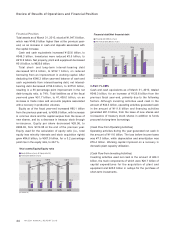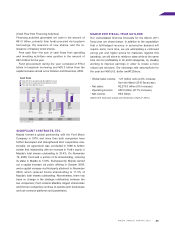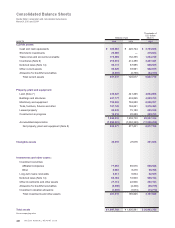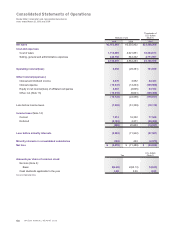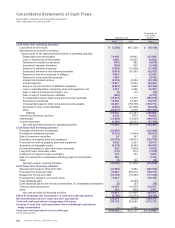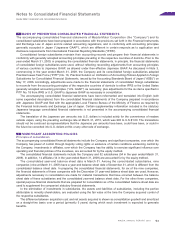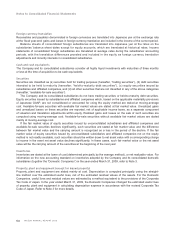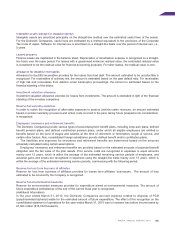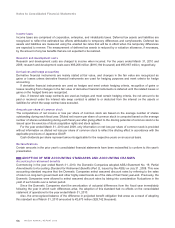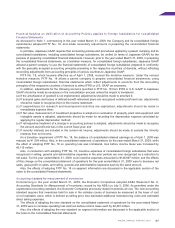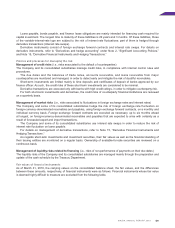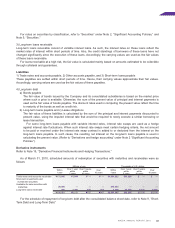Mazda 2010 Annual Report Download - page 56
Download and view the complete annual report
Please find page 56 of the 2010 Mazda annual report below. You can navigate through the pages in the report by either clicking on the pages listed below, or by using the keyword search tool below to find specific information within the annual report.54
Foreign currency translation
Receivables and payables denominated in foreign currencies are translated into Japanese yen at the exchange rate
at the fiscal year-end; gains and losses in foreign currency translation are included in the income of the current period.
Balance sheets of consolidated foreign subsidiaries are translated into Japanese yen at the rates on the
subsidiaries’ balance sheet dates except for equity accounts, which are translated at historical rates. Income
statements of consolidated foreign subsidiaries are translated at average rates during the subsidiaries’ accounting
periods, with the translation differences prorated and included in the equity as foreign currency translation
adjustments and minority interests in consolidated subsidiaries.
Cash and cash equivalents
The Company and its consolidated subsidiaries consider all highly liquid investments with maturities of three months
or less at the time of acquisition to be cash equivalents.
Securities
Securities are classified as (a) securities held for trading purposes (hereafter, “trading securities”), (b) debt securities
intended to be held to maturity (hereafter, “held-to-maturity debt securities”), (c) equity securities issued by
subsidiaries and affiliated companies, and (d) all other securities that are not classified in any of the above categories
(hereafter, “available-for-sale securities”).
The Company and its consolidated subsidiaries do not have trading securities or held-to-maturity debt securities.
Equity securities issued by subsidiaries and affiliated companies which, based on the applicable materiality provisions
of Japanese GAAP, are not consolidated or accounted for using the equity method are stated at moving-average
cost. Available-for-sale securities with available fair market values are stated at fair market value. Unrealized gains
and unrealized losses on these securities are reported, net of applicable income taxes, as a separate component
of valuation and translation adjustments within equity. Realized gains and losses on the sale of such securities are
computed using moving-average cost. Available-for-sale securities without available fair market values are stated
mainly at moving-average cost.
If the fair market value of equity securities issued by unconsolidated subsidiaries and affiliated companies and
available-for-sale securities declines significantly, such securities are stated at fair market value and the difference
between fair market value and the carrying amount is recognized as a loss in the period of the decline. If the fair
market value of equity securities issued by unconsolidated subsidiaries and affiliated companies not on the equity
method is not readily available, such securities should be written down to net asset value with a corresponding charge
to income in the event net asset value declines significantly. In these cases, such fair market value or the net asset
value will be the carrying amount of the securities at the beginning of the next year.
Inventories
Inventories are stated at the lower of cost (determined principally by the average method), or net realizable value. For
information on the new accounting standard on inventories adopted by the Company and its consolidated domestic
subsidiaries (together the “Domestic Companies”) in the year ended March 31, 2009, refer to Note 3.
Property, plant and equipment (except for leased property)
Property, plant and equipment are stated mainly at cost. Depreciation is computed principally using the straight-
line method over the estimated useful lives, net of the estimated residual values of the assets. For the Domestic
Companies, useful lives and residual values are estimated by a method equivalent to the provisions of the Corporate
Tax Code of Japan. In the year ended March 31, 2009, the Domestic Companies changed the estimated useful lives
of property, plant and equipment in calculating depreciation expense in accordance with the revised Corporate Tax
Code of Japan. Refer to Note 3 for more details.


